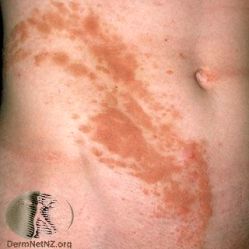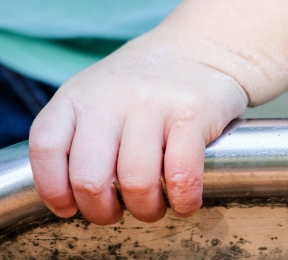Navigating the world of Epidermal Nevus can be confusing. No matter how hard I try, I will never be able to forget the day I received Mermaid’s diagnosis. I know now that it’s going to be ok and we can jump whatever hurdle presents, but I didn’t always feel that way, we are constantly gaining new followers, many who feel the way we all did in the beginning. Lost. I feel like It’s been a while since we have broke down the basics, like what do all these acronyms mean? So many are used interchangeably that it may cause confusion and more fear. So, today I am going to break down 4 of the most commonly used terms surrounding EN that I see. LEN, ILVEN, EHK and ENS. I will touch briefly on other forms but highlight these 4 acronyms.
It is so important to understand that where all these terms refer to Epidermal Nevus, LEN is different than ILVEN, EHK is slightly different than both LEN and ILVEN and MOST IMPORTANTLY, having a diagnosis of Epidermal Nevus does NOT mean that you have the syndrome.
Here is a reminder of Mermaid’s official biopsy report:
-Epidermolytic hyperkeratosis.
Exam demonstrates aconthotic and hyperkeratotic epidermis with focal dyskeratosis. The differential includes linear epidermolytic epidermal nevus and epidermolytic acanthoma.
Though we were told that ILVEN has not yet been ruled out.
(linear epidermal nevus occurs in 1 out of 1,000 people. However, epidermolytic hyperkeratosis only occurs in 1 out of 2/300,000 people worldwide)
Epidermal nevus is a clinical term for a family of skin lesions that involve the outer portion of skin, the epidermis, and are distributed in a linear and often swirled pattern. The lesions may be single or multiple and are usually present at birth. All epidermal nevi show some changes in texture which can range from very rough, warty and spiny, and often darker than the surrounding normal or uninvolved skin (verrucous epidermal nevus), to red and scaly (inflammatory linear verrucous epidermal nevus or ILVEN), to yellowish, rough and pebbly appearance due to proliferation of oil- or ’sebaceous’ gland-like structures (nevus sebaceous).
Epidermal nevi are genetically ‘mosaic’, meaning that the mutation causing the nevi are not found in other cells of the body. Mosaicism arises when the genetic mutation occurs in one of the cells of the early embryo sometime after conception; such mutations are called ‘somatic’ mutations. This mutated cell, like the other normal cells, continues to divide and gives rise to mutated daughter cells that will populate a part of the body. The linear patterning of the epidermal nevus reflects the movement of the mutant daughter cells during fetal growth. These linear, developmental patterns are termed the ‘lines of Blaschko’. Many epidermal cells within these affected areas harbor the mutant gene, while most or all cells from uninvolved areas do not. After birth, the nevus “grows with the child”, although some new areas of involvement and/or extension of the nevus to new areas can occur. ILVEN is an exception: here, lesions often do not appear until later in infancy or childhood.
Types of epidermal naevi:
The skin lesions most often referred to as epidermal naevi are due to an overgrowth of keratinocytes (horny skin cells).
- Linear epidermal naevus
- Epidermolytic epidermal naevus
- Acantholytic epidermal naevus
- Systematised epidermal naevus
- Linear porokeratosis
However, several other conditions are also characterised by benign overgrowth of the epidermis and its appendages (organoid naevi)
- ILVEN
- Sweat gland naevi
- Sebaceous Nevus
- Comedone Nevus
- Becker Nevus
Let’s start with LEN: Linear Epidermal Nevus:

Linear epidermal nevus (LEN) is an uncommon skin condition. It usually affects the limbs and torso on one side of the body. The lesions are typically present at birth. LEN is the result of a genetic abnormality. It is not inherited but arises from somatic mutations in cells that occur after conception.
This is a type of birthmark that is usually present at birth, but may develop later in childhood. They are usually light or dark brown in color. They may start as a flat area in the shape of a line or as a “skin tag.” Over time, they grow and become thicker like a wart. They can be located anywhere on the body. Often, epidermal nevi follow a pattern on the skin known as the lines of Blaschko. The lines of Blaschko, which are invisible on skin, are thought to follow the paths along which cells migrate as the skin develops before birth.
Second is ILVEN: Inflammatory Linear Verrucous Epidermal Nevus:

Inflammatory linear verrucous epidermal nevus is a special kind of epidermal nevus. Like other linear epidermal nevi, ILVEN is characterized by warty lesions that tend to group together in a linear pattern. The difference is that the lesions are red, inflamed and itchy, sometimes intensely so. The surface of the lesions may look like eczema (dry, red, scratched) or like psoriasis (red and scaly).
ILVEN most often affects one leg and may extend from the buttock to the foot. It may be present at birth, but usually arises during the first 5 years of life and spreads over months or years. ILVEN is very rarely observed during adulthood. It is somewhat more common in females.
Next up… EHK: Epidermolytic hyperkeratosis

Epidermolytic hyperkeratosis is a skin disorder that is present at birth. Affected babies may have very red skin (erythroderma) and severe blisters. Because newborns with this disorder are missing the protection provided by normal skin, they are at risk of becoming dehydrated and developing infections in the skin or throughout the body (sepsis).
As affected individuals get older, blistering is less frequent, erythroderma becomes less evident, and the skin becomes thick (hyperkeratotic), especially over joints, on areas of skin that come into contact with each other, or on the scalp or neck. This thickened skin is usually darker than normal. Bacteria can grow in the thick skin, often causing a distinct odor.
Epidermolytic hyperkeratosis can be categorized into two types. People with PS-type epidermolytic hyperkeratosis have thick skin on the palms of their hands and soles of their feet (palmoplantar or palm/sole hyperkeratosis) in addition to other areas of the body. People with the other type, NPS-type, do not have extensive palmoplantar hyperkeratosis but do have hyperkeratosis on other areas of the body.
Epidermolytic hyperkeratosis is part of a group of conditions called ichthyoses, which refers to the scaly skin seen in individuals with related disorders. However, in epidermolytic hyperkeratosis, the skin is thick but not scaly as in some of the other conditions in the group.
Lastly… ENS: Epidermal Nevus Syndrome
The term “epidermal nevus syndrome” has generated significant controversy and confusion in the medical literature. Originally, the term was used to denote a disorder that was actually several different disorders erroneously grouped together. In the recent past, the term was used to denote a specific disorder now known as Schimmelpenning syndrome. However, the term epidermal nevus syndrome could be correctly applied to several different disorders. Therefore, the umbrella term “epidermal nevus syndromes” now represents a group of distinct disorders that have in common the presence of one of the various types of epidermal nevi. However, there is so far no general agreement how to classify the types of this diverse group of disorders, adding to the confusion within the medical literature
Epidermal nevus syndromes (ENSs) are a group of rare complex disorders characterized by the presence of skin lesions known as epidermal nevi associated with additional extra-cutaneous abnormalities, most often affecting the brain, eye and skeletal systems. Epidermal nevi are overgrowths of structures and tissue of the epidermis, the outermost layer of the skin.
In ENS, neurological involvement may include:
- Epilepsy or infantile spasms.
- Intellectual impairment.
- Structural or vascular brain abnormalities.
- Spinal lesions.
Skeletal involvement includes:
- Incomplete formation of bony structures – eg, spina bifida.
- Hypoplasia of bones.
- Bony cysts.
- Asymmetry of the skull or spine.
- Spontaneous fractures and rickets.
Ophthalmic involvement includes:
- Colobomas.
- Strabismus.
- Ptosis.
- Nystagmus.
- Corneal opacities.
- Retinal changes.
- Various other ocular abnormalities which have been described.
Endocrine features have been reported:
- Hypophosphataemic vitamin D-resistant rickets has occurred in a number of cases.
- Precocious puberty has been described in several cases.
Syndrome of inappropriate antidiuretic hormone (SIADH) has been reported in one case.
Other potential complications of EN:
Complications due to Epidermal Nevus are rare; but, it is observed that there is an association with the development of basal cell carcinoma, squamous cell carcinoma, keratoacanthoma, and clear cell acanthoma.
It is suggested to search for dysplastic kidney disease in patients with neurocutaneous disorders. Neurocutaneous syndromes are disorders that lead to growth of tumors in various parts of the body. One being a Wilm’s tumor. They’re caused by the abnormal development of cells in an embryo and characterized by the tumors in various parts of the body (including the nervous system) and by certain differences in the skin. It is important to understand this is very rare but something to be aware of.
Whew, that was a lot of information, I hope it brought a small amount of clarity surrounding all the terms thrown out there.
Thanks for walking with us today!
Mermaid’s Mommy
Great job, Maria! This information is difficult to find and digest. I’m sure this will be helpful to many people.
LikeLike
Thank you. This is very informative and helpful. Im so glad I found your blog. I am still trying to find the right diagnosis for my son but I feel like he has LEN in his armpits and is slowly spreading to his left arm. We are in the Philippines.
LikeLiked by 1 person
🙂
LikeLike